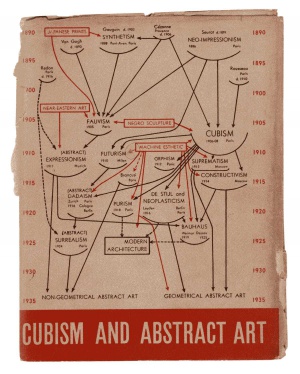Research point 1
Listen to Gabriel Orozco talking about the ‘Working Table’ pieces. In your learning log/blog reflect on his comments in relation to your own work for this project. How do Orozco’s descriptions of his working process resonate with your own methods and approach?
Gabriel Orozco Working Tables: LINK 15
Listening to the discussion by the artists about his work. His collection is of experiments he did over the years and kept in shoe boxes. He enjoys looking at the tools or leftovers of an artist, as evidence of a process. It is interesting that he keeps his works around this piece, which he calls things/objects/not finished made works/experiments in shoe boxes – like a filing system and as evidence of work made, tried, attempts. I can immediately relate to it – it is like walking into my husband’s carpentry workshop – there is not just the smell and materials, there is evidence of work being made, work which is still in progress, work that was left – all in different areas. I know my studio looks the same – I have things in boxes, on shelves, on window sills, on the easels, on tables, in plastic containers and bags, and even stuff on the floor! As of late I have been walking on the farmyard, around the stores, and collected smaller lengths of wire which I saw as suitable to make 3d objects back in the studio.
Research Point 2
Explore the early Cubist works of Pablo Picasso and George Braque online, in books or in journals. If you can visit a gallery to see them.
What were the influences on Cubism
How did the Cubists seek to represent the three-dimensional reality of objects and space? What are the similarities in these works to a non-western approach?
Look at this image by 20th Century artist Henri Matisse. How do you feel he is challenging the conventions of the western perspective? How does this impact on you as the viewer?

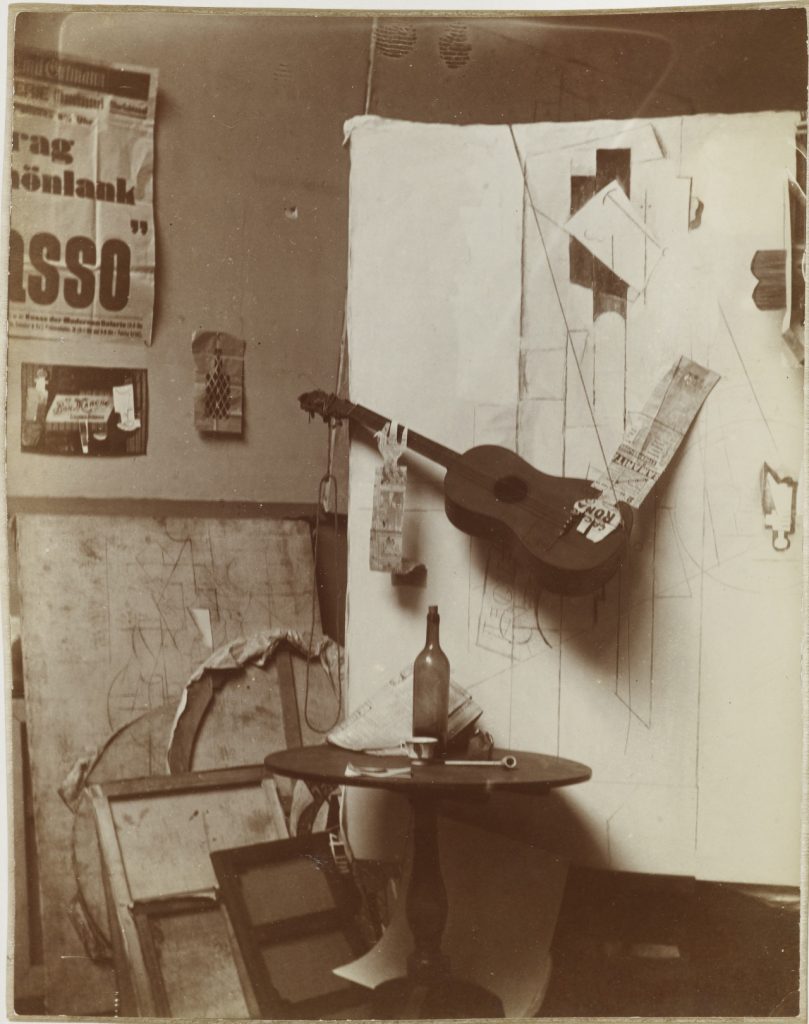

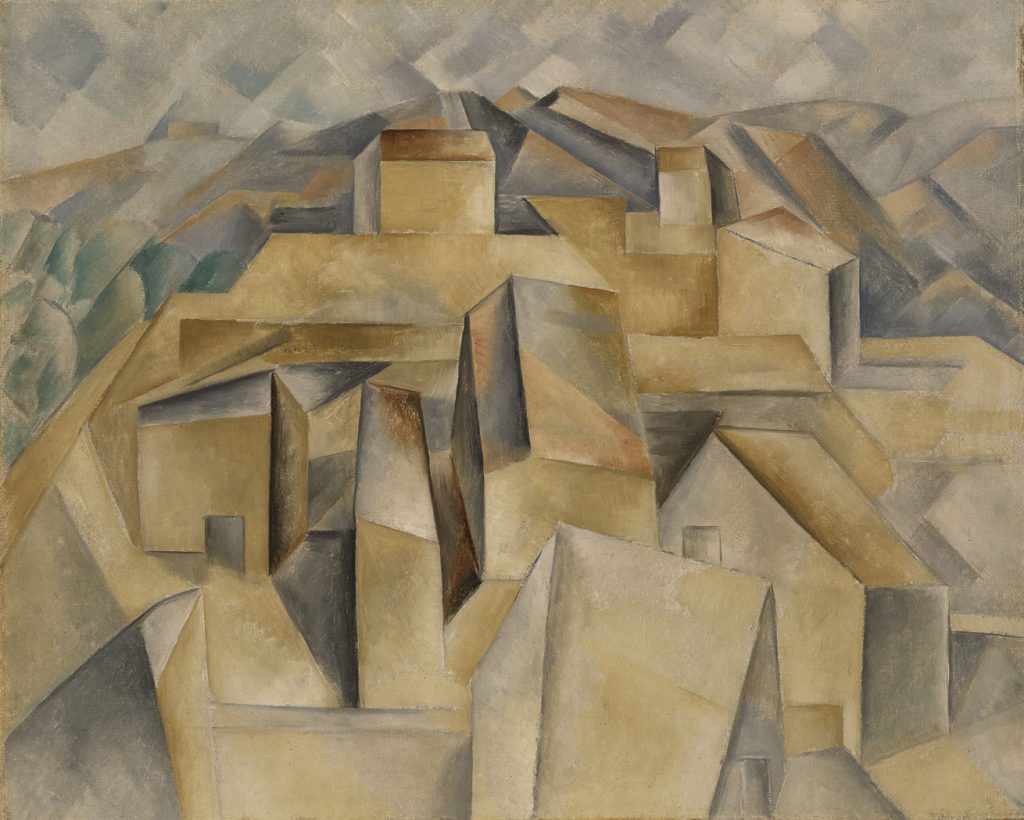
Gemälde / Öl auf Leinwand (1909) von
Pablo Picasso [1881 – 1973]
Bildmaß 65,09 x 81,28 cm
Person: Pablo Picasso [1881 – 1973]
Systematik:
Personen / Künstler / Picasso / Werke / Museum Berggruen / allgemein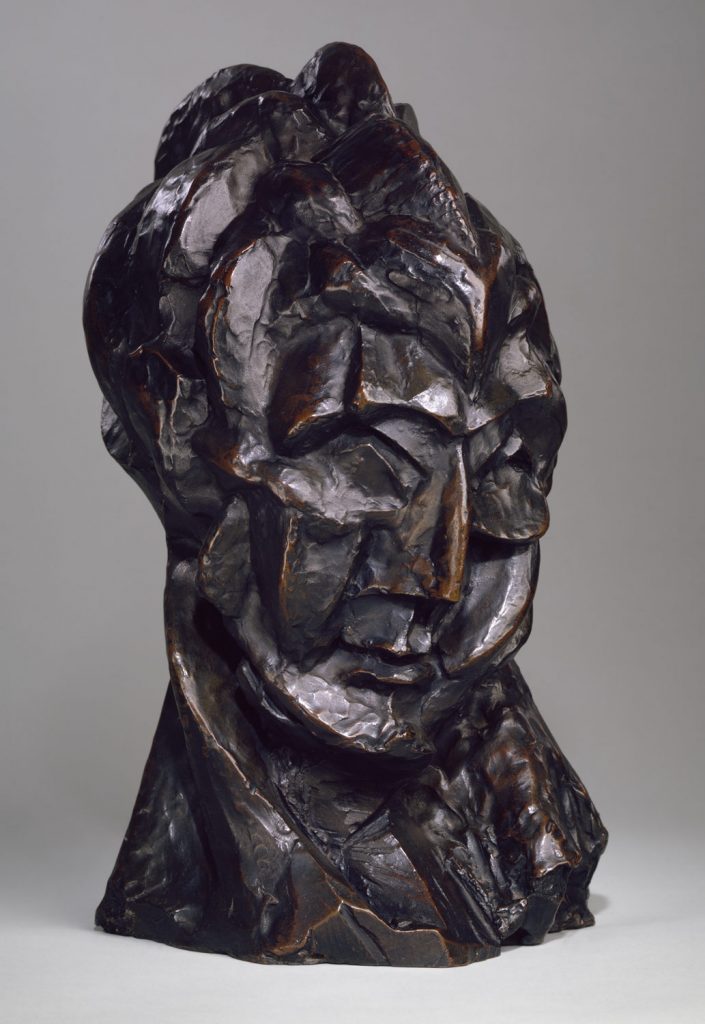
Working Title/Artist: Woman’s Head Department: Modern Art Culture/Period/Location: HB/TOA Date Code: Working Date: 1909 photography by mma 1991, transparency #3 view#1 scanned and retouched by film and media (jn) 12_22_04
Above are the early works of both these artists I found on Monoskop site. During October 2018 I visited Barcelona and the Picasso Museum. I spent time with Las Minas and saw most of Picasso’s 58 interpretations, and saw some of his sculptures, and then found an exhibition of his work together with Francis Picabia. This exhibition was called Picasso Picabia: Questioning Painting These works were mostly done before 1920. Picabia embraced Orphism and later reduced his painting to subtle monochromes splashed with dots. Both these artists challenged pictorial conventions which were established by art history and were driven by freedom of creativity. I will share my photos as taken during that visit, below. According to the info shown by the gallery, I understood that for Picasso it was about freeing his artistic language from imitation. I learnt that for Picasso it was about art that is “essentially about forms”. Picabia became increasing abstract between 1912 and 1913 and focussed on movement and dance. Apparently, Picasso rejects his ‘sensory abstraction’ as he saw it as placing importance on the subject, whereas his focus was on the object. Here I read his words, “Respect the object” on the gallery walls.
The friendship as artists and having an artistic collaboration, helped Picasso and Braque to invent Cubism. This was a new style of painting that shattered traditional forms of artistic representation. It became clear for these two artists that depicting 3d form in traditional methods in art was a form of illusion that did not give the viewer a real experience of the object, meaning that it was not showing things as they really are. By using different angles of viewing a subject one could give the viewer a better understanding of three-dimensional qualities, which does not include perspective and or shading. Their aim was to show things as they really are, so they used flat geometric shapes. This also emphasized the two-dimensional flatness of the canvas. Their belief as Cubists was ….” that a painting should not pretend to be like a window onto a realistic scene but as a flat surface it should behave like one.” (Tate, ) The name ‘cubism’ has derived from a comment by a critic, who when he saw Braque’s work at an exhibition in Paris in 1908, the the work was redicng everything to geometric outlines – to cubes.
It seems this development can be split into two distinct phases. According to the Tate website, “The first phase, analytical cubism is considered to have run until around 1912. Objects are split into lots of flat shapes representing the views of them from different angles, and muted colours and darker tones or shades are used. In their works one sees the different views of subjects, which usually were objects or figures together in the same picture, which resulted that the paintings appear fragment and abstracted.
The second phase, synthetic cubism, involves simpler shapes and brighter colours (and looks more light-hearted and fun!)”The term analytical cubism describes the early phase of cubism, generally considered to run from 1908–12, characterised by a fragmentary appearance of multiple viewpoints and overlapping planes. Cubism was followed in Germany, Spain, Italy, Czech rep and became an international movement with manifestos on cubist art and ideas. Other artists in this movement were: Gertrude Stein, Fernand Leger, Francis Picabia, G Apollinaire, Henri le Fauconnier, and many others. The first major text on Cubism was written by Albert Gleizes and Jean Metzinger, in 1912, called Du “Cubisme”.
It seems that Alfred Barr declared in 1936, during the Cubism and Abstract Art exhibition at MoMA, “that the day’s most adventurous artists had grown bored with painting facts. By a common and powerful impulse, they were driven to abandon the imitation of natural appearance.” To demonstrate the breadth of this modernist impulse toward abstraction, Barr assembled a wide-ranging exhibition of nearly 400 works of painting, drawing, printmaking, sculpture, architecture, furniture, theatre design, and typography. He also drew up a now-famous diagram of the origins and influences of modern art that was reproduced on the catalogue’s dust jacket. (moma.org). On this website, I also had accessed video discussions on Picasso’s, work, Three Musicians,1921, which is seen as Synthetic Cubism. This is a large work done in oil, 6f high, to understand I have to think about the scale of the works of the old masters, clearly not something a viewer online can easily grasp. One gets an idea how the artists would have started cutting up forms and putting the paper together to create forms – collage. I remember that during my visit at the Picasso Museum in Barcelona I saw many of his works from an early age, which confirms he was a good draughtsman and painter at a young age. He studied the masters at the Madrid Acadamy of Fine arts for one year, but never stopped making art. His life in Paris, Mont Marte is most probably where he took steps into Cubism and how his work started to change. (I was always intrigued with his paintings in his Blue Period, 1901-1904) See two below. I have a printed copy of the Mother and Child with handkerchief.
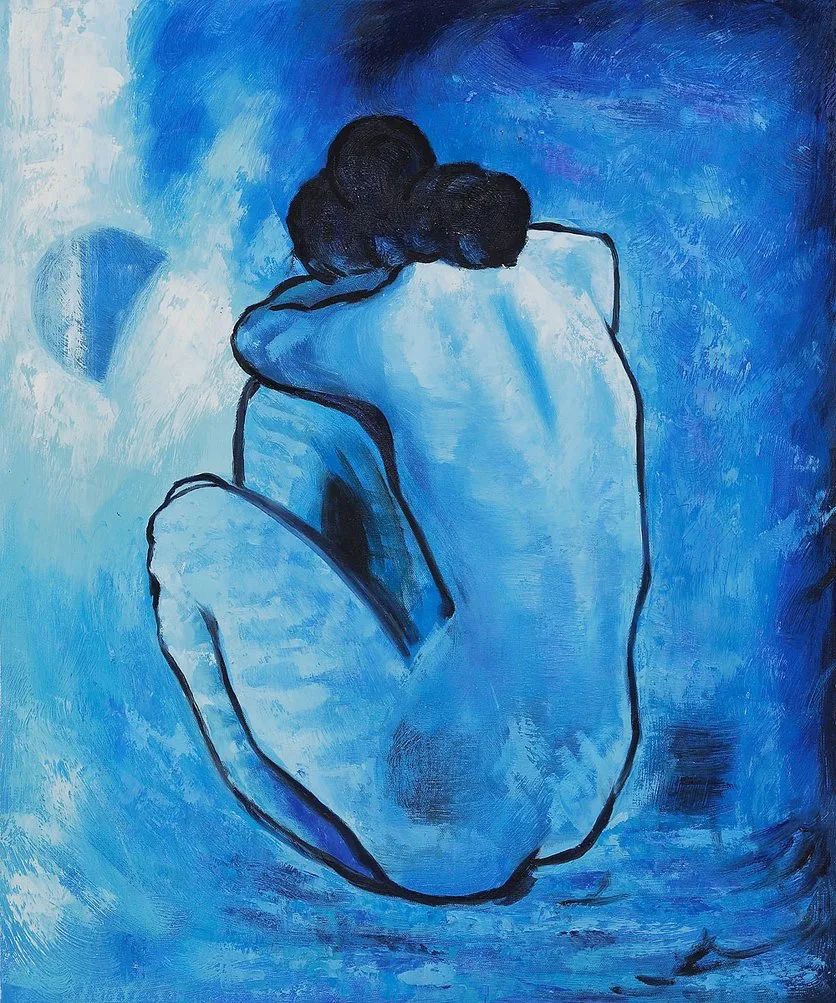
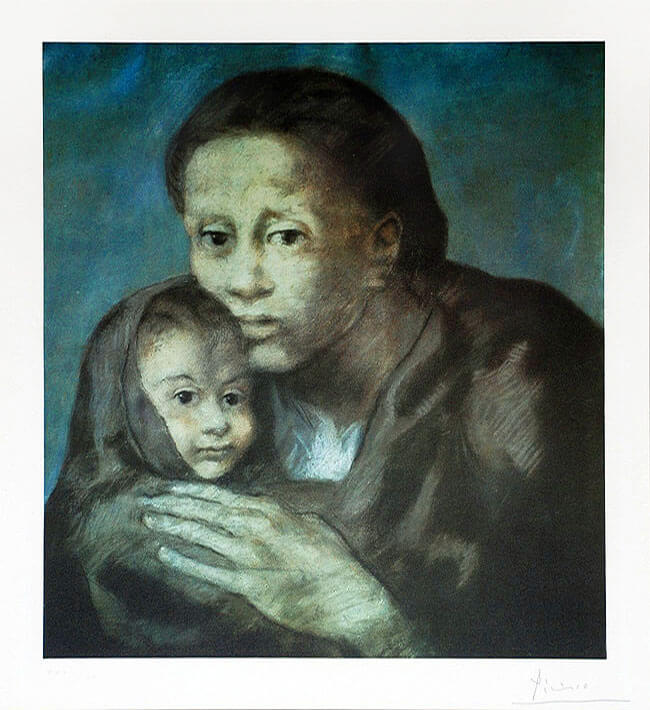
The tribal objects of African Masks inspired his work to become more raw since he moved to France, 1904. One tends to look at Les Demoiselles d’Avignon, 1907. I have always felt a strong stare from those 5 ladies in the work. From here on his paintings became more Cubist and Abstract, very distorted and fragmented forms, flattened picture, no perspective – clearly finding new viewpoints. Culture was also being influenced, modernity and development of Art Deco, fashion, popular styles of dressing, seems to be linked to Cubism in the 1920’s onwards.
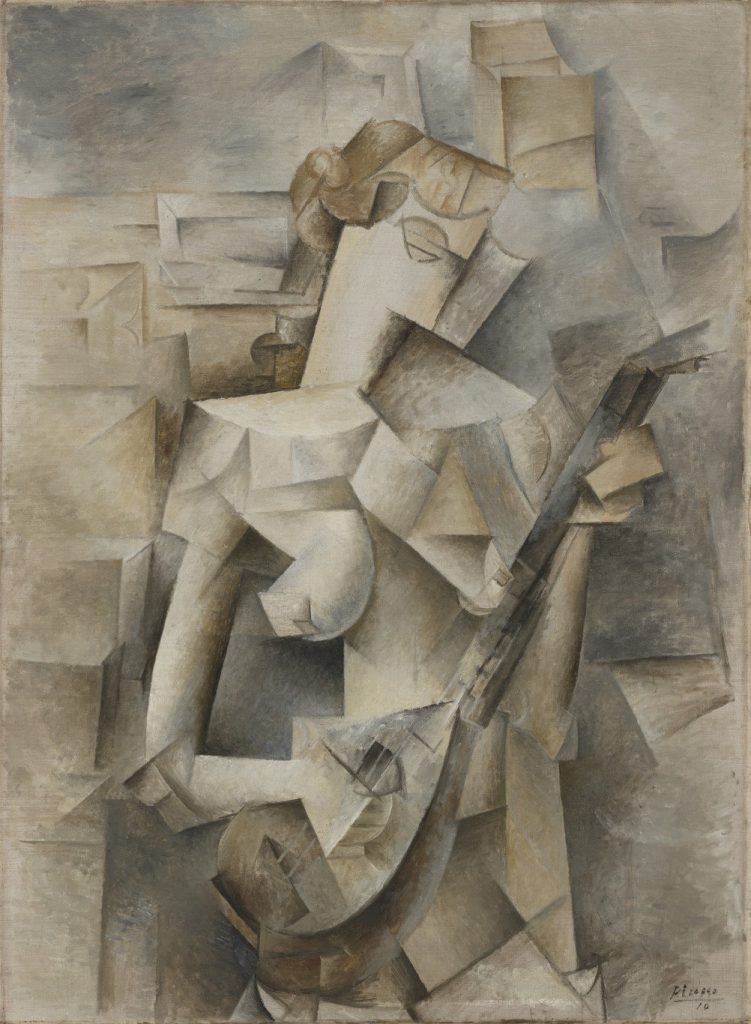
I feel one can see how these ideas opened new possibilities into how an artist can treat reality – that which is seen, and how it could become the starting point for more new styles, abstract art like constructivism and neo-plasticism.
Henry Matisse, Red Interior: Still life on a Blue Table, 1947 – How is he challenging the conventions of western perspective? How does this impact on you as the viewer?
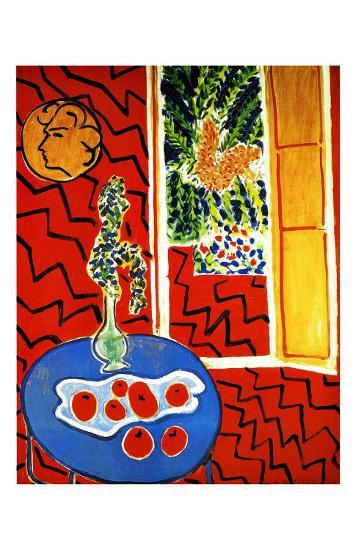
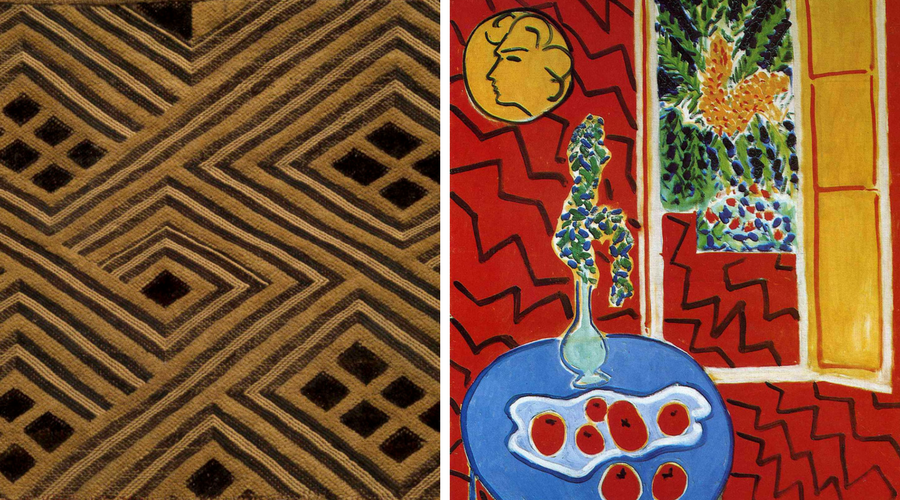
Kuba Cloth from Matisse’s Collection, artist unknown. Right Red Interior still life on a blue table, Matisse, 1942
To me colour and line is the first thing that comes to mind when I look at these works – how Matisse knew what is enough colour and how he uses line! He uses pure colours to fill his objects and model them, not tone. He does not mix his colour a lot. He was a master of composition, even in the above work we see it as making sense, but gravity is defied as well as perspective as we know it. I feel I see the influence of cut-outs in his work, as well as African art (see image on Right side) Perspective and space are challenged different than that of the Cubist – I find it easier to make sense of the picture on view. This makes one think about illusion and that he leaves out certain detail very effectively. The painting style is again focused on how he sees the different objects and want the viewer to see it. He also looks at space within his works – what and how objects occupy these spaces and the emptiness which is around them is filled with mark-making lines, and he challenges gravity in the viewpoints he paints. Almost the whole work is covered with the pattern on red as if saying that design is important when showing objects or everyday views or still life. Looking through the window I recognise that there are no vanishing points. Reading and thinking about his work it became clear that reality and imagination are the main considerations in his work – he shows what he wants us to see, which is mostly imagined – a type of illusion to translate what he sees onto a 2-dimensional paper?
Bibliography
Fennel. D K, 2017 The Objects of Matisse , a blog written on Matisse in the Studio, at the Museum of Fine Arts, Boston and Royal Acadamy of Arts, London. accessed on 15 August 2021
Research Point 3
Read the work ‘Tender Buttons’ by poet, Gertrude Stein. How does her use of language resonate with the visual work of the Cubists?
Her use of adjectives and verbs forces the reader to think/reconsider everyday objects. It touches on our preconceptions and associations with objects. I see the work was written in 1914 as experimental work and after reading the text I become aware of how image and text are used in this poem. Is it a form of literary abstraction? I understand by looking for more context of this work, that it is often compared with music and Cubist imagery. In Tender Buttons, the objects are a carafe, teacups, plates, umbrella, ribbon, etc., all very colorful described. In my view, almost by a person with synesthesia? Objects are described as precious commodities like nickel, silver, and copper along with the stone malachite, and can one say that many of the goods she listed have colonial implications, such as coffee, feathers, sugar, Japanese tea sets, cocoa, cigarettes, or does it imply trade? I look at the table and try and find the connection between the current study materials and how we look at objects displayed on a table. Am I looking at how things have different meanings – other perspectives, not only one meaning? In a way, I feel the writer moves between what makes sense, and what not, what I understand and then what I do not. I almost get the idea she is trying to making us hear/look/see what the object is or could be if we just try and look from a different perspective. Is it in the way how Cubists ‘composed’ a familiar thing in a new way, to make the viewer see beyond representation/meaning? Is it about composition? I do think there is something of this happening. I am not familiar with her work and will consider if I want to understand or explore it – at this moment it does not resonate with my learning experience, but I know I should spend more time on the reading.
Listen to ‘Cultural Exchange”‘ in which the author AS Byatt talks to Mark Lawson about Henri Matisse’s The Red Studio
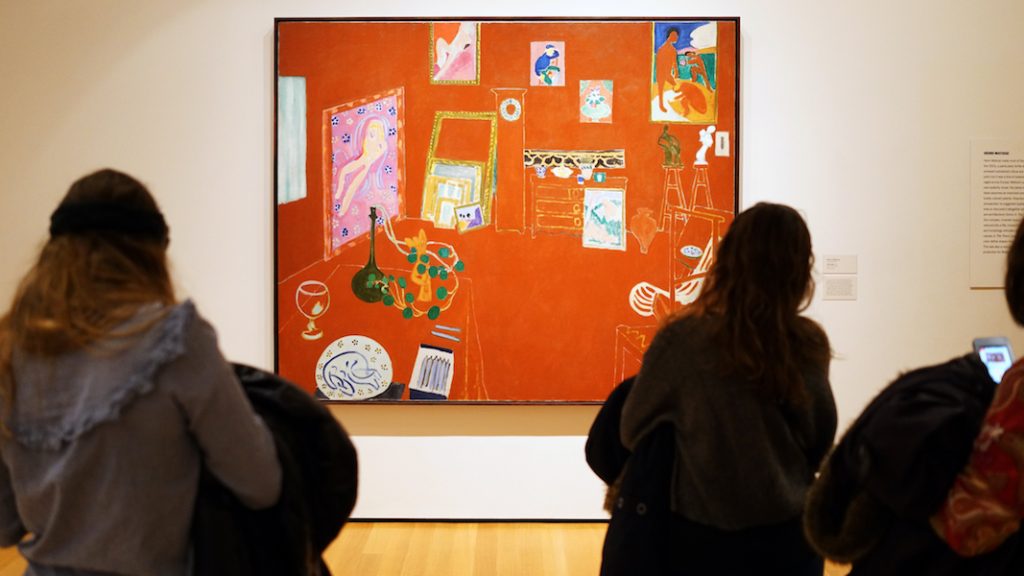
A S Byatt have used Matisse’s colourful Still life art (as well as others artists) as part of her narratives which relies on pictorial detail, where showing prevails over telling. In the conversation, she sees the work as the same way in which her mind works in terms of a visual/spatial memory and that the work spoke to something very primitive inside herself. She admires Matisse’s sense to place things on the red background – how things are arranged in relation to each other. As a writer of novels, she also has objects which she moves around. For her the work is Matisse’s way of painting the process of how things relate to each other. She reminds that he took a long time to complete this work. This reminds me again of looking at my table with objects as Still Lifes.
My own understanding of his use of red is that it helped Matisse to dispel all the spatial properties of the many objects in the studio, Matisse shows me that he is concerned with expression as his observation, it is about his composition and how the objects as proportions in space are used. He created harmony in the picture.
Dr. Beth Harris and Dr. Steven Zucker, “Henri Matisse, The Red Studio,” in Smarthistory, August 9, 2015, accessed August 16, 2021,
Research Point 4
Aran’s Toolbox of actions for how to solve the day in the studio
Valerie Mrejen, Start Working
Reflection about my own approach to, and feelings about being in the studio. What is my relationship to my workspace. What does my workspace provide me with?
Research Point 5
The Combines challenges many aspects of painting and sculpture. I find the possibilities of collaboration intriguing. During the research, I felt this a huge topic to cover in the course and that one has to really be committed to this process of exploration to be truthful in your making. I am interested in using language or prose in my work. In many ways, I thought of the effect of scale gravity on materials – much like how Phyllida Barlow and Jessica Stockholder use materiality in their making.
Reading point on Contextual focus point
It seems to me that Fried was mostly concerned with modernism versus minimalist art, and theatricality versus object-hood, and presentness versus presence – all dichotomies of art. He calls minimal art, “literalist art”, because of its tendency to confront the viewer with the existence of the art objects. By doing this the viewer becomes aware of his relationship towards the art works. Fried calls this theatricality, and then he develops a complete theory of aesthetic communication. He was concerned about the theatrical relation sculpture was considering ,as he was more attracted to the suspension of the sense of duration of an experience with art and the suspension of object hood.
I do feel it necessary to look at the time when Fried wrote this essay and his then role as art critique, very mich linked to art history, due to his own biology. I understand that he drew a lot of his tacit understandings due to his own interactions with artists and writers and the influence they had on each other. He also looked at history and the art critiques like Diderot, who also championed certain modernist artists.
What I understand is the role of objects and how it resonated with my making during this part of the course, also how I can describe this encounter. To me this reading is very much about the viewer, as Fried refers to as the ‘beholder’ in his essay. I feel that when I studied more about Phyllida Barlow’s ideas on sculpting, I came to understand how large scale objects compete with my awareness of space and place, a presence. My own works are much smaller, but I do see them as having a sense of presence, but that this experience becomes more important than the object itself. I believe both our visceral and visual language is part of art. In these works I made I focussed on the materials I used, I learnt from them, experimented with them and it gave me huge pleasure to explore them. I did use a subject, that of my gestural drawing/ painting mark making, but the work soon developed into their own unique forms. Barlow talks about our interactions with sculpture, having longing to touch, move closer and how our bodies engage with this, looking up, down, around, across……objects being choreographed? The viewer is encouraged to move more, as if looking becomes the subject?
Higgie, Jennifer Conversations Phyllida Barlow: the edges of things, on website of Hauser & Wirth ,as an article and youtube video. (hauserwith.com/ursula/31536-phyllida-barlow-the-edges-of-things)
